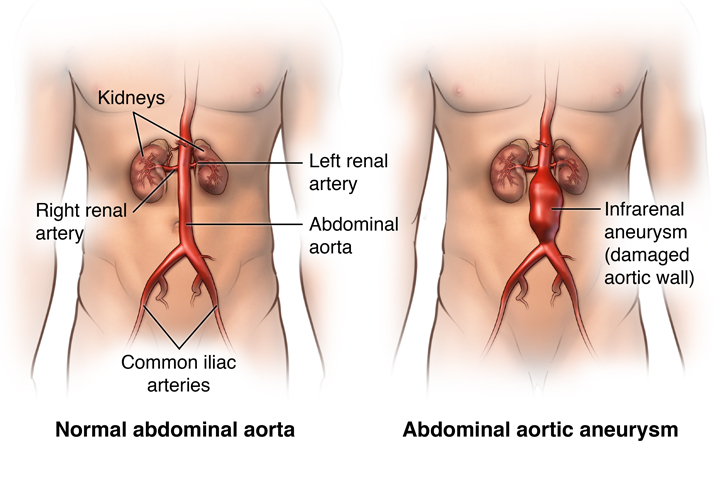Page Contents
OVERVIEW
This page is dedicated to organizing various examples of standardized exam questions whose answer is an abdominal aortic aneurysm (AAA). While this may seem a odd practice, it is useful to see multiple examples of how a AAA will be characterized on standardized exams (namely the boards and the shelf exams). This page is not meant to be used as a traditional question bank (as all of the answers will be the same), however seeing the classic “test” characterization for a disease is quite valuable.

KEY CHARACTERISTICS OF THIS CONDITION (ON EXAMS)
When it comes to standardized exams, each condition has its own “code” marked by key buzzwords, lab findings, clues, etc. If you are well versed in this code you will be able to more quickly identify the condition that is being discussed, and get the right answer on the exam you are taking. Below is the “code” for a AAA.
Chief Complaints:
- Can be asymptomatic
- Abdominal/back/flank pain are all possible
Patient History:
- Smoker
- History of hypertension
Clinical Workup:
- Hypotension + tachycardia can be present in the setting of rupture
- Pulsatile abodminla mass can be felt on physical exam (midline/central in location)
- Abdominal bruit may be present upon auscultation.
- Decreased lower extremity pulses may be detected due to the pathology of the condition
QUESTION EXAMPLES
Question # 1
A 65 year old man is found to have a 5 cm pulsatile mass deep in the abdomen. It is found between the xiphoid and the umbilicus.
Explanation # 1
Pulsatile abdominal mass = AAA
Question # 2
A 70 year old male is seen in the ER for the sudden onset of back pain. This began an our ago when he began to feel a constant pain in his back. It is not associated with straining, sneezing, or coughing. He has not been lifting anything before it started, and he has never felt anything like this before. His past medical history is notable for prostate cancer that was treated with a radical prostatectomy as well as radiation. His temperature is 98.8°F, heart rate is 114, blood pressure is 85/40 mm Hg, and respirations are 23/min. A straight leg test is negative bilaterally, there is no tenderness to the spinal processes. The abdominal exam reveals the presence of a pulsatile mass that is tender to palpation. What is the likely diagnosis in this patient?
Explanation # 2
Pulsatile abdominal mass = AAA
Question # 3
A 72 year old male comes to the urgent care clinic complain of back pain that has been occurring this past week. It is steady, dull, and he localizes it to his lower back. He is a smoker, drinks regularly, however denies every using any illicit drugs. His past medical history is notable for hypertension and diabetes. He is medically managed for his conditions, however has run out of his medications for the past 3 weeks due to an insurance mix-up. He denies experiencing any trauma to his back and has no other symptoms. His vitals are within normal limits except for a blood pressure of 165/75 mm Hg. A physical exam reveals to tenderness over the spinous processes and there are no step-offs. The patient has a n obese abdomen, and there is a pulsatile mass palpated in the left lower quadrant. What is the likely diagnosis?
Explanation # 3
Pulsatile abdominal mass = AAA
Question # 4
A 65 year old male comes to the his physician for a routine checkup. He has a past history of hypertension and also suffers from osteoarthritis. His past medical history is notable for a 45 pack year history of smoking. Currently his blood pressure is 145/85 mm Hg and his heart rate is 84 bpm. A physical exam reveals the presence of a pulsating central abdominal mass but is otherwise normal. What is the likely diagnosis in this patient?
Explanation # 4
Pulsatile abdominal mass = AAA
Question # 5
A 75 year old male comes to the ER after he develops sudden weakness, nausea, and lower back/abdomen pain. He explains that his pain radiates down to his legs. Currently his heart rate is 115 bpm and his blood pressure is 88/62 mm Hg. A physical exam reveals weak pulses in the lower extremities, and a faint bruit that is heard in the lower abdomen. What is a possible diagnosis in this patient?
Explanation # 5
Lower back/abdominal pain + tachycardia and hypotension + abdominal bruit + diminished lower pulses = AAA (likely leaking/ruptured)
Question # 6
A 70 year old male is brought to the hospital because he has been experiencing abdominal pain for the past few hours. Currently his blood pressure is 90/60 mm Hg, his pulse is 120 bpm, and his respirations are 15/min. A abdominal exam is conducted that shows guarding and rigidity. A pulsatile peri-umbilical mass is also detected. What is the likely diagnosis in this patient?
Explanation # 6
Pulsatile abdominal mass = AAA
TESTABLE FACTS ABOUT THIS CONDITION (BEYOND ITS IDENTIFICATION)
Many questions on standardized exams go beyond simply recognizing the underlying condition. Often there are specific testable facts regarding some aspect of the disease’s pathophysiology/management/clinical implications that are commonly asked. Some of these are listed below:
Page Updated: 03.31.2018